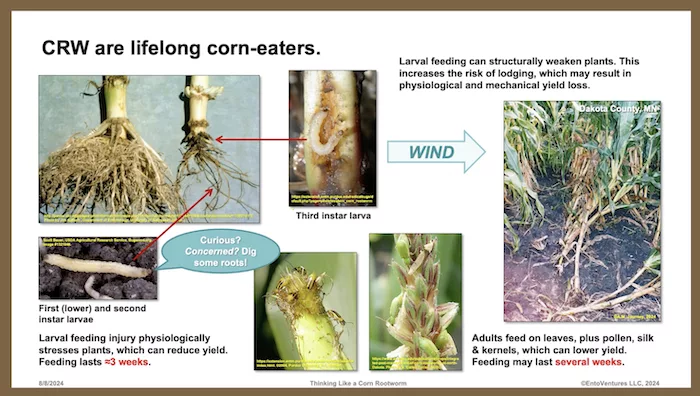Start thinking like a corn rootworm, and you’ll have a better shot at keeping the yield-robbing pest from taking over your strip-tilled cornfields. Those are some words of advice from Ann Marie Journey, an independent soil, wetland and stream health evaluator and founder of EntoVentures LLC.
“When you approach the rootworm as just a problem that has to be solved, you’re not taking into account the animal’s biology,” Journey says. “You’re hitting it just at certain points or with certain methods or controls, and you’re not allowing yourself in effect to have a conversation to gain insight back from the rootworms about what it is that makes them successful in any given place. The more you know about what is making them successful, the more you might be able to make their life more complicated.”
Journey, who conducted extensive research on corn rootworm, insecticides and herbicide-tolerant and rootworm-resistant corn at the Univ. of Minnesota, shared critical information about the “billion-dollar bug” at the 2024 National Strip-Tillage Conference, along with 5 practices that could make your farm more rootworm-resilient.
Resilience Practice #1: Minimize Disturbance
Healthy soils with plenty of life are a rootworm’s worst nightmare because they’re easy targets to be eaten by viruses, bacteria, protists (algae, flagellates, amoebae), fungi, nematodes, worms, arthropods (centipedes, millipedes, mites, spiders, springtails, insects) and vertebrates.

“In healthy soil, you might have 5-20,000 pounds of these organisms per acre in the top 6 inches,” Journey says. “There should be a lot of these natural enemies to corn rootworms there. There could be 10 billion microbes in a single teaspoon of soil representing 11,000 species.
“The soil should be a lively place,” she adds. “It’s estimated that there are 10 quintillion live insects on this planet at any given time, and 90% of them spend part of their life cycle in the soil.”
Conventional tillage damages pore structure in the soil, making it harder for the rootworm’s enemies to survive and thrive. Minimizing disturbance with strip-till or no-till is a good place to start in the quest for rootworm resilience.
Resilience Practice #2: Increase Plant Diversity
Journey encourages strip-tillers to increase their plant diversity to bring as many natural rootworm enemies into the mix as possible. She points to a field at the Menoken Farm in Bismarck, N.D., as a good blueprint for rootworm resilience.
 “The field has the wall of corn with cover crops in between, and that place is just absolutely buzzing with insects,” Journey says. “They were also running chickens in there who were picking out even more insects and then actively searching for them. What you have there is a case where there are lots of different roots feeding the soil. They’re creating lots of different rhizospheres. There are several different opportunities for natural enemies of corn rootworm to get established besides just on the corn.”
“The field has the wall of corn with cover crops in between, and that place is just absolutely buzzing with insects,” Journey says. “They were also running chickens in there who were picking out even more insects and then actively searching for them. What you have there is a case where there are lots of different roots feeding the soil. They’re creating lots of different rhizospheres. There are several different opportunities for natural enemies of corn rootworm to get established besides just on the corn.”
Resilience Practice #3: Keep the Soil Covered
Cover crops not only protect the soil, but they provide much needed shade to keep the rootworm's enemies alive on hot, summer days.

“When the soil temperature is between 95 and 113 degrees, you start losing the soil bacteria, you’re cooking it,” Journey says. “The higher the soil temperature, the higher the stress on the corn plants. If the corn plant has already lost part of its root system, then the stress is exponentially greater due to the temperature.”
Resilience Practice #4: Maintain Living Roots
The key is to not just have more plants on the land, but to have them on the land longer, Journey says.
“There’s evidence out there that having cover crops in the fall over the winter increases the number of predators that are there in the spring that will take out corn rootworms.”

Resilience Practice #5: Make the Rootworm’s Life More Complicated
Managing rootworm larvae is a saga of unintended consequences, Journey says. Large-scale, continuous cornfields were a post-World War II boon for rootworms, and a complicated environment was simplified, much to their liking.
“We've been at this for over a hundred years, and what happened really was that right after World War II, this is the break in the action, things got bigger about corn,” Journey says. “Very suddenly you got bigger fields, bigger yields, bigger demand, bigger coverage because of irrigation. You've got bigger machines, you've got new hybrids, you've got insecticides, you've got synthetic fertilizers. There was all that wonderful industrial activity that came out of World War II. Consequently, the soil that I was talking about as being a very complex and complicated place became much simpler, and rootworms loved it.

“We keep throwing these existential crises at corn rootworm and we're dealing with an animal,” she adds. “It does chemical warfare for a living. It lives in this complex, deadly place, and we keep saying, ‘OK, we're going to do this (apply insecticides). Now you're either going to go away or you're going to adapt.’ And every single time it adapts because we keep throwing existential crises at landscape scale, and we do the same thing years and years and years in a row. All of these technologies are still good as long as you don't use them year after year after year. It has to be used thoughtfully.”
Journey says the goal should be to make the rootworm’s life more complicated by implementing layers of natural control — like cover crops, no-till and strip-till — so that you can have natural checks and balances within your system.
Click here to watch Ann Marie Journey's National Strip-Tillage Conference presentation, "How to Make Your Operation More Rootworm-Resilient."







